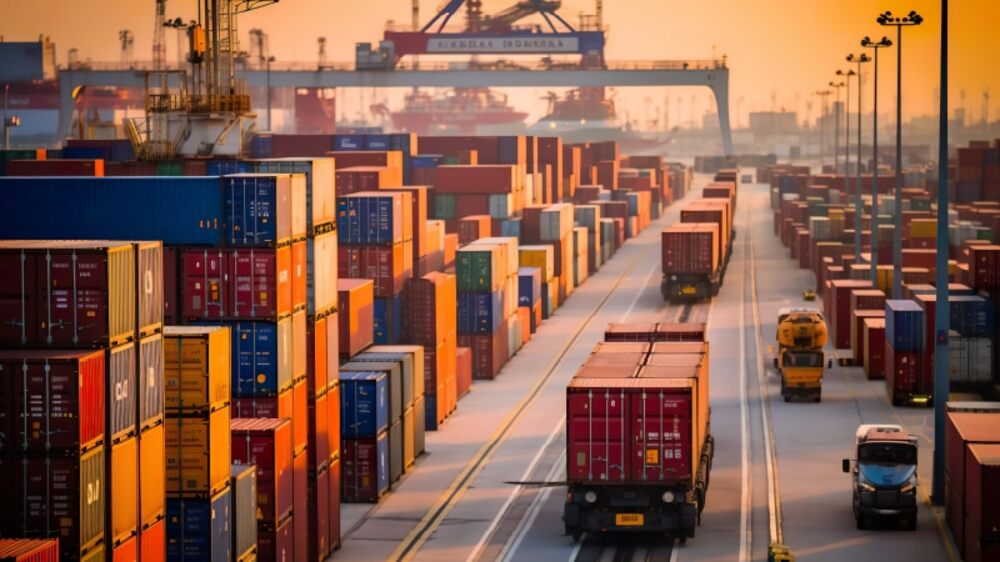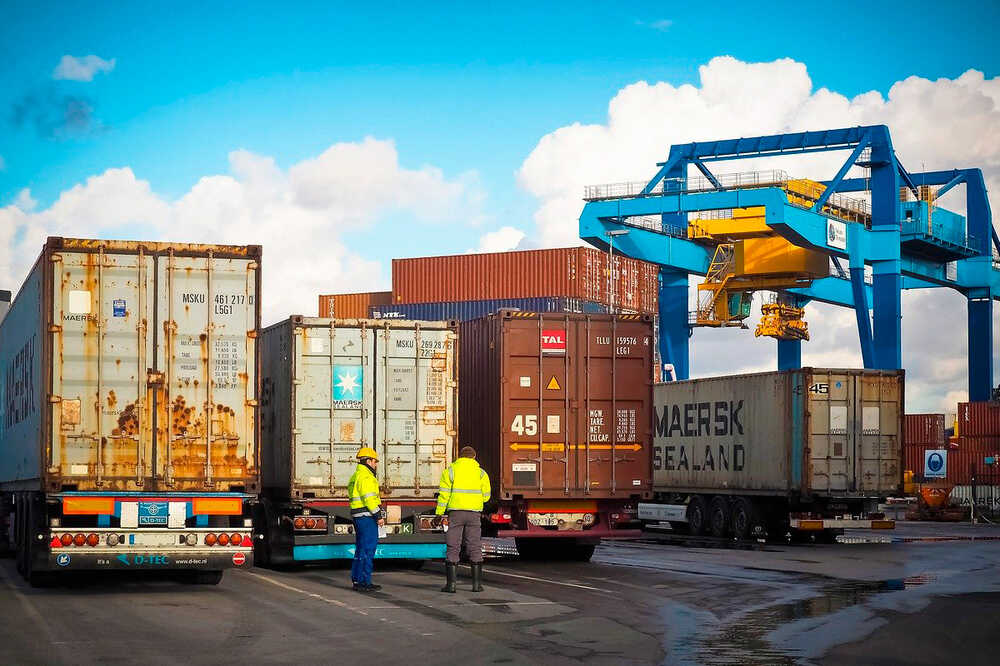The growing need for efficient freight transportation has made drayage trucking services a vital component of modern supply chains. These services seamlessly connect different transportation modes, ensuring goods move quickly and reliably.
As industries increasingly depend on interconnected logistics networks, drayage helps maintain operational efficiency, minimize transit delays, and prevent congestion at major hubs. With the global drayage services market projected to grow by USD 3.60 billion from 2024 to 2028, the demand for reliable drayage solutions continues to rise.
Without effective drayage operations, businesses risk higher costs, shipment delays, and disruptions in product availability.
Table of Contents
Key Takeaways
✔ These services are essential for maintaining supply chain efficiency, reducing congestion at transportation hubs, and supporting global trade. ✔ The industry faces challenges such as strict environmental regulations, driver shortages, and rising fuel and operational costs. ✔ Choosing the right drayage provider requires evaluating experience, fleet capabilities, compliance with regulations, pricing transparency, and customer service. |
What Drayage Trucking Services Entail
Drayage trucking services play a critical role in the logistics and transportation industry by facilitating the short-distance movement of goods. These services ensure that cargo is efficiently transferred between ports, rail yards, and warehouses, allowing supply chains to function smoothly.
Short-Distance Transportation of Goods
Drayage truck transportation services specialize in the movement of goods over short distances, typically within the same metropolitan area or between closely located logistics hubs. This short-haul transportation is crucial for maintaining an efficient supply chain and reducing congestion at major transportation hubs.
- Quick Cargo Transfers: Drayage services ensure that shipping containers and freight are swiftly moved from one transportation point to another. This helps prevent congestion at ports and rail yards, keeping supply chains moving efficiently.
- Last-Mile Delivery Support: These services assist in delivering goods to their final distribution points, whether they are retail stores, warehouses, or customers. By bridging the gap between large transportation hubs and final destinations, drayage ensures timely deliveries.
- Time-Sensitive Shipments: Many businesses rely on intermodal drayage trucking for urgent shipments that require a seamless transition between different transportation modes. Efficient drayage helps prevent delays that could disrupt supply chains.
Connection Between Ports, Rail Yards, and Warehouses
Drayage trucking services serve as a vital link between major transportation centers, enabling the smooth transfer of goods between ships, trains, and storage facilities. Without drayage, freight movement would be inefficient and susceptible to delays.
- Port Drayage: Drayage trucking for shipping is essential for transporting cargo from seaports to nearby distribution centers or rail terminals. This service helps facilitate international trade by ensuring that imported and exported goods reach their next destination quickly.
- Rail Yard Drayage: Freight drayage trucking is crucial for moving containers from rail terminals to warehouses or distribution centers. Since trains deliver large shipments over long distances, drayage services help complete the journey by transferring goods to their final destination.
- Warehouse Transfers: Heavy-duty drayage trucking is used to move large and heavy shipments between warehouses, production facilities, and processing centers. This type of drayage is particularly important for industries dealing with oversized cargo that requires specialized handling.
Key Industries That Rely on Drayage Services
A wide range of industries depends on drayage truck transportation services to keep their supply chains running smoothly. These businesses require reliable and efficient transportation solutions to ensure the timely movement of goods.
- Retail and E-Commerce: Companies in the retail sector rely on drayage services to restock their stores and fulfill online orders. Efficient transportation ensures that products are available to meet consumer demand.
- Manufacturing: Manufacturers depend on freight drayage trucking to transport raw materials and finished products between suppliers, production plants, and distribution hubs. This service is crucial for keeping production lines running without interruptions.
- Automotive Industry: Car manufacturers use drayage trucking services to move vehicle components and finished automobiles between factories, storage yards, and shipping facilities. Reliable drayage is necessary to meet production and distribution deadlines.
- Food and Beverage: Perishable goods require fast and efficient transportation to prevent spoilage. Drayage services help ensure that food products reach grocery stores, restaurants, and distribution centers in optimal condition.
- Pharmaceuticals: The healthcare industry depends on drayage trucking for shipping medical supplies, equipment, and pharmaceuticals to hospitals and distribution centers. Timely deliveries are critical to ensuring that essential medical products reach their destinations without delays.
Why Drayage Trucking Services are Crucial
Drayage trucking services play a vital role in modern logistics, ensuring the smooth movement of goods between key transportation hubs. By facilitating efficient cargo transfers, these services help businesses maintain supply chain efficiency, reduce congestion at critical points, and support global trade.
1. Enhancing Supply Chain Efficiency
Intermodal drayage trucking is an essential part of the supply chain, connecting various modes of transportation, such as ships, trains, and trucks. Without efficient drayage solutions, goods may face delays, leading to increased costs and disruptions.
- Seamless Cargo Transfers: Drayage trucking services move freight between ports, rail yards, and warehouses, minimizing delays in delivery schedules.
- Reduced Storage Costs: Quick transport of containers helps businesses avoid costly storage fees at ports and terminals.
- Improved Delivery Speed: Fast movement of goods through drayage trucking for shipping helps businesses meet customer demands on time.
- Optimized Freight Handling: Freight drayage trucking ensures that cargo is handled properly, reducing the risk of damage and loss.
2. Reducing Congestion at Ports and Rail Terminals
Congestion at major ports and rail terminals can slow down the entire transportation system, leading to inefficiencies and increased costs. Drayage truck transportation services help alleviate these challenges by ensuring that goods are swiftly moved out of these high-traffic areas.
- Efficient Cargo Flow: Drayage services prevent bottlenecks by ensuring that containers are quickly transferred to their next destination.
- Reduced Dwell Times: Minimizing the time cargo spends at ports and terminals helps free up space for incoming shipments.
- Better Use of Infrastructure: Heavy-duty drayage trucking enables large cargo loads to be transported efficiently, reducing the number of trips required.
- Lower Environmental Impact: Faster movement of goods reduces idling times, helping to lower emissions and fuel consumption.
3. Supporting Global Trade and Commerce
Drayage trucking services are crucial to international trade, ensuring that goods move seamlessly across supply chains. As businesses rely on fast and reliable transportation, drayage services help maintain the flow of goods both domestically and globally.
- Stronger Trade Networks: Effective drayage trucking services connect ports, rail terminals, and distribution centers, supporting the global movement of products.
- Cost-Effective Transportation: By reducing storage fees and improving delivery times, businesses can lower transportation costs and remain competitive.
- Support for Importers and Exporters: Drayage services play a key role in helping businesses move goods between international and domestic markets.
- Scalability for Growing Markets: Freight drayage trucking adapts to changing trade demands, ensuring businesses can scale operations as needed.
Challenges in Drayage Trucking
Drayage trucking services play a critical role in the supply chain by transporting goods between ports, rail yards, and distribution centers. However, several challenges impact the efficiency and cost-effectiveness of these operations.
1. Environmental Regulations and Emissions Concerns
The drayage trucking industry is heavily impacted by environmental regulations designed to reduce pollution and greenhouse gas emissions. Since intermodal drayage trucking often involves short-haul routes in urban areas, meeting these environmental standards is both necessary and challenging.
- Emission Standards Compliance: Government agencies enforce strict emission regulations that require drayage trucking services to transition to low-emission or zero-emission vehicles. Companies must invest in newer trucks that meet these environmental standards.
- Transition to Electric and Alternative Fuel Vehicles: Many heavy-duty drayage trucking companies are shifting toward electric trucks or those powered by alternative fuels such as natural gas and hydrogen. These vehicles help reduce carbon footprints but come with high initial costs.
- Port Restrictions on Diesel Trucks: Some major ports have implemented restrictions on older diesel trucks to minimize air pollution. This regulation forces businesses to upgrade their fleets or face limitations on where they can operate.
2. Driver Shortages and Labor Constraints
A shortage of skilled drivers continues to be a significant challenge in the freight drayage trucking industry. The lack of qualified personnel results in delayed shipments, higher labor costs, and increased pressure on existing drivers.
- Aging Workforce: A large percentage of truck drivers are nearing retirement age, and fewer younger individuals are entering the profession. This labor shortage affects the availability of drayage truck transportation services.
- High Turnover Rates: Many drivers leave the industry due to long hours, demanding schedules, and difficult working conditions. Companies struggle to retain employees, leading to disruptions in transportation services.
- Training and Licensing Requirements: Obtaining a commercial driver’s license (CDL) and the necessary training for drayage trucking for shipping requires time and financial investment. The lengthy certification process slows down the recruitment of new drivers.
3. Rising Fuel and Operational Costs
The cost of fuel and other operational expenses directly affects the profitability of drayage trucking services. Companies must find ways to manage these expenses while maintaining efficient delivery operations.
- Fluctuating Fuel Prices: Fuel costs are unpredictable and influenced by global market changes, often rising in the spring and peaking in late summer when travel demand increases. These seasonal trends, combined with broader economic factors, contribute to higher freight drayage trucking costs, impacting overall supply chain expenses.
- Maintenance and Equipment Upgrades: Drayage trucks require regular maintenance to ensure reliability and efficiency. The transition to fuel-efficient or electric trucks requires significant financial investment.
- Port and Terminal Fees: Many ports and rail terminals impose additional fees for drayage truck transportation services. These costs add to the financial burden of trucking companies and can lead to higher shipping rates for customers.
Tips for Choosing Drayage Trucking Services
Selecting the right drayage trucking services is essential for ensuring efficient and cost-effective freight transportation. Since drayage plays a critical role in moving goods between ports, rail terminals, and warehouses, businesses must carefully evaluate their options to avoid delays and additional costs.
1. Assess Experience and Industry Expertise
When choosing a drayage trucking provider, it is important to select a company with extensive experience in the industry. Established providers understand the complexities of port operations, customs regulations, and terminal requirements. Companies with a strong track record in intermodal drayage trucking are more likely to provide efficient and timely services. Their familiarity with local transportation networks also allows them to navigate challenges such as congestion and scheduling conflicts effectively.
2. Evaluate Fleet Capabilities and Equipment
The quality and condition of a drayage company’s fleet play a significant role in service reliability. A provider with well-maintained trucks and specialized equipment for freight drayage trucking ensures the safe and efficient transportation of goods. It is also beneficial to choose a company that invests in modern technology, such as GPS tracking and automated dispatch systems.
3. Ensure Compliance with Environmental and Safety Regulations
Drayage trucking for shipping must comply with strict environmental and safety regulations. Many ports and terminals enforce policies that restrict older, high-emission diesel trucks to reduce air pollution. A reputable drayage trucking company should meet emission standards and, if possible, offer eco-friendly options such as electric or alternative fuel trucks. Additionally, safety compliance is crucial to prevent accidents and ensure the secure transport of goods.
4. Compare Pricing and Cost Transparency
Cost is a major factor when selecting drayage truck transportation services, but the cheapest option is not always the best. Transparent pricing and clear cost breakdowns help businesses understand what they are paying for and prevent hidden fees. Factors such as fuel surcharges, port fees, and storage costs should be discussed upfront.
5. Review Customer Service and Communication
Strong customer service and clear communication are essential when working with a drayage trucking company. A provider with responsive support and real-time shipment tracking can help businesses avoid uncertainties and delays. Reliable communication ensures that any issues, such as unexpected delays or changes in scheduling, are promptly addressed.
6. Consider Specialized Services for Unique Freight Needs
Not all freight shipments are the same, and some require specialized handling. Heavy-duty drayage trucking services may be necessary for oversized or high-value cargo. Businesses should choose a provider with experience in handling their specific freight requirements, whether it involves refrigerated goods, hazardous materials, or oversized loads.
Frequently Asked Questions
How is drayage different from regular trucking?
Drayage trucking focuses on short-distance hauls, while regular trucking often involves long-distance transport across states or even countries. Drayage trucks usually carry shipping containers that have been offloaded from cargo ships or trains. Regular trucking can involve various types of freight, including palletized goods, refrigerated items, and bulk shipments. Another key difference is that drayage trucks often operate within ports and terminals, requiring special permits and security clearance. Regular trucking companies typically handle direct deliveries to businesses, warehouses, or stores.
How long does a typical drayage trip take?
A typical drayage trip can take anywhere from a few minutes to several hours, depending on the distance and location. If the cargo is being moved within the same port or terminal, the trip might take less than an hour. When transporting goods to a nearby warehouse or distribution center, the trip could take a few hours. However, delays can occur due to traffic, port congestion, or customs processing. Some drayage trips may take longer if the cargo needs to be transferred between different transport modes.
Do drayage trucks operate 24/7?
Drayage trucking companies often operate around the clock, especially in busy port cities. Many ports and terminals are open 24/7, allowing drayage drivers to pick up and deliver cargo at all hours. However, some companies may have specific operating hours based on demand and business agreements. Nighttime drayage is common to avoid peak traffic hours and speed up delivery times. Some trucking companies also adjust their schedules based on port congestion and appointment requirements.
How does weather affect drayage trucking?
Weather can significantly impact drayage trucking, especially in regions prone to heavy rain, snow, or storms. Poor weather conditions can slow down traffic, making deliveries take longer than expected. Ports may also experience delays if extreme weather prevents ships from unloading cargo on time. Snow and ice can create hazardous driving conditions, requiring extra precautions for truck drivers. Strong winds can pose risks when transporting high-profile containers, increasing the chance of tipping.
How do businesses schedule drayage services?
Businesses schedule drayage services by contacting trucking companies or working with freight brokers. Many companies offer online booking systems, allowing businesses to request pickup and delivery times in advance. Scheduling depends on factors like port availability, container readiness, and warehouse space. Some shipments require pre-scheduled appointments to avoid long wait times at terminals. Communication between shippers, trucking companies, and port operators is key to ensuring smooth logistics.
Partner with the Best Drayage Services in New York City!
Ensure smooth and efficient cargo transportation with Drayage Company By Best, the trusted provider of drayage trucking services in New York City. Whether you need reliable freight transfers between ports, rail yards, or warehouses, our team is equipped to handle your logistics needs with precision and speed. We specialize in timely, cost-effective, and compliant drayage solutions that keep your supply chain moving without delays.
Contact Drayage Company By Best today to streamline your freight operations with a dependable partner in New York City.



